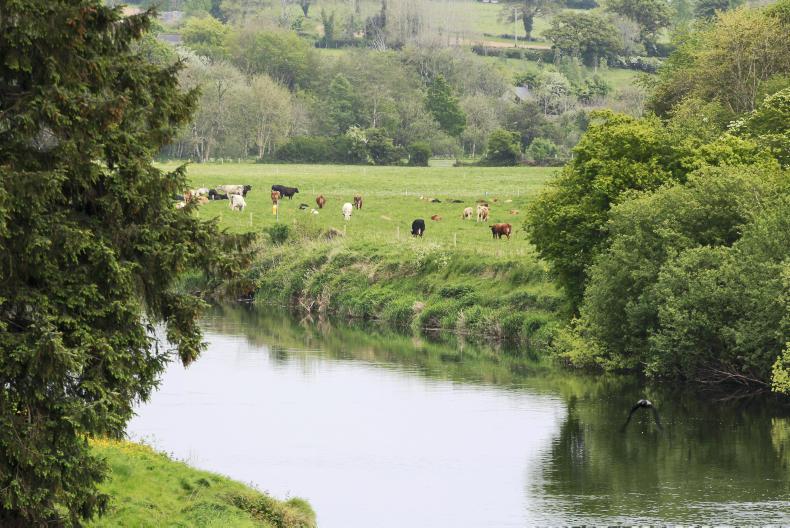Farmers in several counties have been contacted by environment officers enforcing spraying and spreading buffer zones around drinking water extraction points.
A farmer in Co Mayo told the Irish Farmers Journal that a council officer had arranged a meeting last month to inform him of restrictions to slurry, fertiliser and pesticide use up to 250m around a plant drawing water from a river.
“There is no problem with that – we drink the water ourselves, we completely understand,” the farmer said, adding that the land in question was marginal and not currently sprayed or fertilised. “However, this land is now officially agriculturally worthless, with no value if we want to sell it in the future,” he added, raising the issue of compensation.
Water executive scientist for Mayo County Council Olivia Feeney confirmed that the local authority was assessing all land for “potential for pollution within close proximity to a public water supply scheme” within a 250m radius, in application of nitrates regulations updated last year. She said that officers were meeting individual farmers to map affected land and answer any questions.
“A formal letter is then issued to the landholder, again with detailed maps included,” as well as contact numbers for further queries. “Local authorities do not offer compensation on statutory obligations,” she said.
The Irish Farmers Journal understands that farmers have been approached in similar ways in counties Laois, Wexford and Tipperary in recent months. A spokesperson for the Environmental Protection Agency (EPA) confirmed that two statutory instruments underpin the restrictions, one from last year applying the latest nitrates action programme and one applicable since November 2015 on pesticides. They provide for spreading and spraying setbacks ranging from 25m to 200m from drinking water extraction points depending on their size – down to 5m for pesticide use around the smallest sites.
“In relation to the landspreading of slurry and manure, Part 4 of the good agricultural practices regulation allows local authorities (or Irish Water) to reduce to a minimum distance if they have completed a technical assessment and it indicates there is no health risk as a consequence,” the EPA spokesperson added. The regulations allow setbacks of 15m to 30m only if local conditions including soil and water quality records show it to be safe.
“This flexibility was broadly ignored by local authorities” despite being available since the previous review of the nitrates action programme in 2010, the IFA said in its submission on the new regulations last year. “These buffer zones or setback distances prohibit the spreading of fertilisers, lead to yield losses and income losses and are essentially land designations,” the association added.
Read more
MCPA in 80% of drinking water pesticide contaminations
Farmers to be supported in the event of shortages – Irish Water
Farmers in several counties have been contacted by environment officers enforcing spraying and spreading buffer zones around drinking water extraction points.
A farmer in Co Mayo told the Irish Farmers Journal that a council officer had arranged a meeting last month to inform him of restrictions to slurry, fertiliser and pesticide use up to 250m around a plant drawing water from a river.
“There is no problem with that – we drink the water ourselves, we completely understand,” the farmer said, adding that the land in question was marginal and not currently sprayed or fertilised. “However, this land is now officially agriculturally worthless, with no value if we want to sell it in the future,” he added, raising the issue of compensation.
Water executive scientist for Mayo County Council Olivia Feeney confirmed that the local authority was assessing all land for “potential for pollution within close proximity to a public water supply scheme” within a 250m radius, in application of nitrates regulations updated last year. She said that officers were meeting individual farmers to map affected land and answer any questions.
“A formal letter is then issued to the landholder, again with detailed maps included,” as well as contact numbers for further queries. “Local authorities do not offer compensation on statutory obligations,” she said.
The Irish Farmers Journal understands that farmers have been approached in similar ways in counties Laois, Wexford and Tipperary in recent months. A spokesperson for the Environmental Protection Agency (EPA) confirmed that two statutory instruments underpin the restrictions, one from last year applying the latest nitrates action programme and one applicable since November 2015 on pesticides. They provide for spreading and spraying setbacks ranging from 25m to 200m from drinking water extraction points depending on their size – down to 5m for pesticide use around the smallest sites.
“In relation to the landspreading of slurry and manure, Part 4 of the good agricultural practices regulation allows local authorities (or Irish Water) to reduce to a minimum distance if they have completed a technical assessment and it indicates there is no health risk as a consequence,” the EPA spokesperson added. The regulations allow setbacks of 15m to 30m only if local conditions including soil and water quality records show it to be safe.
“This flexibility was broadly ignored by local authorities” despite being available since the previous review of the nitrates action programme in 2010, the IFA said in its submission on the new regulations last year. “These buffer zones or setback distances prohibit the spreading of fertilisers, lead to yield losses and income losses and are essentially land designations,” the association added.
Read more
MCPA in 80% of drinking water pesticide contaminations
Farmers to be supported in the event of shortages – Irish Water






 This is a subscriber-only article
This is a subscriber-only article










SHARING OPTIONS: